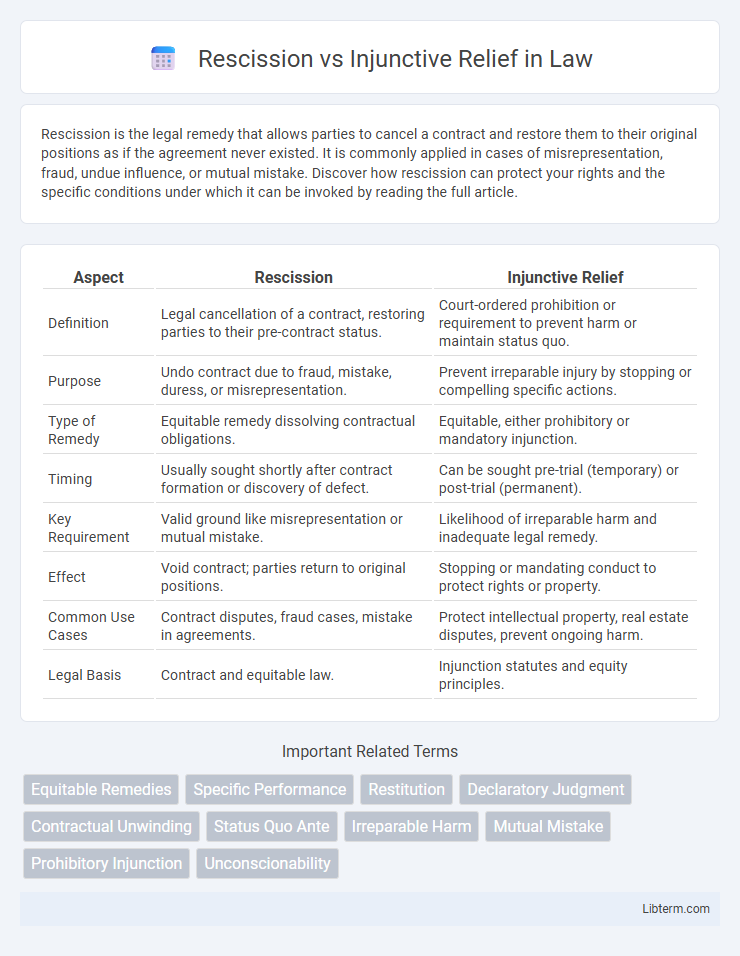Rescission is the legal remedy that allows parties to cancel a contract and restore them to their original positions as if the agreement never existed. It is commonly applied in cases of misrepresentation, fraud, undue influence, or mutual mistake. Discover how rescission can protect your rights and the specific conditions under which it can be invoked by reading the full article.
Table of Comparison
| Aspect | Rescission | Injunctive Relief |
|---|---|---|
| Definition | Legal cancellation of a contract, restoring parties to their pre-contract status. | Court-ordered prohibition or requirement to prevent harm or maintain status quo. |
| Purpose | Undo contract due to fraud, mistake, duress, or misrepresentation. | Prevent irreparable injury by stopping or compelling specific actions. |
| Type of Remedy | Equitable remedy dissolving contractual obligations. | Equitable, either prohibitory or mandatory injunction. |
| Timing | Usually sought shortly after contract formation or discovery of defect. | Can be sought pre-trial (temporary) or post-trial (permanent). |
| Key Requirement | Valid ground like misrepresentation or mutual mistake. | Likelihood of irreparable harm and inadequate legal remedy. |
| Effect | Void contract; parties return to original positions. | Stopping or mandating conduct to protect rights or property. |
| Common Use Cases | Contract disputes, fraud cases, mistake in agreements. | Protect intellectual property, real estate disputes, prevent ongoing harm. |
| Legal Basis | Contract and equitable law. | Injunction statutes and equity principles. |
Understanding Rescission: Definition and Purpose
Rescission is a legal remedy that cancels a contract and restores the parties to their original positions before the agreement. Its primary purpose is to address situations involving misrepresentation, fraud, mistake, or undue influence, effectively nullifying the contract's effects. This remedy prevents unjust enrichment and ensures fairness by undoing agreements that are fundamentally flawed or unfairly induced.
What is Injunctive Relief? An Overview
Injunctive relief is a court-ordered remedy that compels a party to do or refrain from specific acts to prevent harm or preserve the status quo. It is commonly used in cases involving contracts, property disputes, and intellectual property, where monetary damages are insufficient. This equitable remedy ensures immediate prevention of irreparable harm by mandating or prohibiting actions through temporary, preliminary, or permanent injunctions.
Key Differences Between Rescission and Injunctive Relief
Rescission cancels a contract, effectively restoring parties to their pre-contractual state, while injunctive relief prevents or orders specific actions to avoid harm. Rescission is an equitable remedy voiding agreements due to misrepresentation or mutual mistake, whereas injunctive relief enforces or restrains conduct to maintain legal rights. The primary difference lies in rescission's focus on undoing agreements versus injunctive relief's role in regulating behavior to prevent ongoing or future damage.
Legal Grounds for Rescission in Contracts
Legal grounds for rescission in contracts primarily include fraud, misrepresentation, undue influence, duress, mutual mistake, and impossibility of performance. Rescission allows parties to undo a contract when these factors undermine the contract's validity or consent, effectively restoring them to their pre-contractual position. Unlike injunctive relief, which seeks to prevent or compel specific actions, rescission nullifies the contract based on significant legal defects.
Types of Injunctive Relief in Civil Litigation
In civil litigation, injunctive relief is a court-ordered remedy requiring a party to do or refrain from specific acts, categorized into preliminary, permanent, and temporary restraining orders. Preliminary injunctions maintain the status quo during trial, while permanent injunctions provide a final order after judgment, and temporary restraining orders address immediate and urgent harm before a hearing. Rescission, by contrast, voids contracts or agreements to restore parties to their original positions, focusing on undoing obligations rather than compelling or preventing actions as injunctions do.
When is Rescission the Appropriate Remedy?
Rescission is the appropriate remedy when a contract is voidable due to misrepresentation, fraud, undue influence, or mutual mistake, effectively undoing the agreement and restoring parties to their pre-contractual positions. It is favored when monetary damages are insufficient to address the harm or when ongoing contractual obligations are impossible or inequitable to enforce. Courts grant rescission to prevent unjust enrichment and ensure fairness, particularly in cases where consent was not genuinely obtained.
Circumstances Warranting Injunctive Relief
Injunctive relief is warranted when a party faces imminent harm that cannot be adequately remedied by monetary damages, such as ongoing or threatened breaches of contract, intellectual property infringement, or violations of personal rights. Courts grant injunctions to maintain the status quo and prevent irreparable injury, often requiring clear evidence of potential harm and the lack of alternative remedies. This equitable relief is essential in circumstances where timely intervention is necessary to avoid substantial and irreversible damage.
Comparing the Legal Processes: Rescission vs Injunction
Rescission involves the court voiding a contract and returning parties to their pre-contractual positions, often triggered by misrepresentation or fraud, and requires proving a valid ground for cancellation. Injunctive relief, on the other hand, commands a party to do or refrain from specific actions to prevent irreparable harm, typically used to preserve the status quo during litigation. The rescission process focuses on undoing obligations, while injunctions emphasize immediate, enforceable directives to control conduct.
Court Considerations in Granting Each Remedy
Courts consider the nature of the harm and the adequacy of legal remedies when granting rescission or injunctive relief, prioritizing rescission to nullify contracts tainted by fraud or mutual mistake, restoring parties to their original positions. Injunctive relief is favored when preventing ongoing or imminent harm, especially where monetary damages fail to provide effective compensation. The balance of equities and public interest also critically influence judicial decisions between these two equitable remedies.
Practical Implications: Choosing Between Rescission and Injunctive Relief
Rescission voids a contract, restoring parties to their pre-agreement positions, making it ideal when the agreement is fundamentally flawed or fraudulently induced. Injunctive relief, by contrast, preserves the contract while preventing specific actions, useful for stopping breaches without nullifying obligations. Practitioners must weigh whether restoring status quo or enforcing contract terms better protects client interests and aligns with case objectives.
Rescission Infographic

 libterm.com
libterm.com